Mercedes-Benz S-Class: Difference between revisions
| Line 109: | Line 109: | ||
==S-Class models== |
==S-Class models== |
||
==W116 (1972-1980)== |
|||
{{Infobox automobile |
{{Infobox automobile |
||
| image = 450SELI 0411.jpg |
| image = 450SELI 0411.jpg |
||
Revision as of 11:05, 21 February 2014
| Mercedes-Benz S-Class | |
|---|---|
 | |
| Overview | |
| Manufacturer | Mercedes-Benz |
| Production | 1954–present |
| Assembly | Sindelfingen, Germany Toluca, Mexico Chakan, Pune, India Ho Chi Minh City,Vietnam Pekan, Pahang, Malaysia |
| Body and chassis | |
| Class | Full-size luxury car |
| Body style | 4-door sedan |
The Mercedes-Benz S-Class is a series of luxury sedans produced by German automaker Mercedes-Benz, a division of German company Daimler AG. The classification was officially introduced in 1972 with the W116 S-Class, which succeeded previous Mercedes-Benz models dating to the mid-1950s. The S-Class has served as the flagship model for Mercedes for over fifty years in its various incarnations. The S-Class has debuted many of the company's latest innovations, including drivetrain technologies, interior features, and safety systems (such as the first seatbelt pretensioners).[1] The S-Class has ranked as the world's best-selling luxury sedan,[2] and its latest generation, the W222 S-Class, premiered in 2013. As in previous iterations, the W221 S-Class is sold in standard- and long-wheelbase versions; I4, V6, V8, V12, diesel and hybrid powertrains are offered. All models built in Mexico or sold in the United States are only available in long wheelbase.
"S-Class" is the anglicized version of "S-Klasse," a German abbreviation of "Sonderklasse," which means "special class" (in the sense of "a class of its own"). In automotive terms it refers to "a specially outfitted car." Although used colloquially for decades, following its official application in 1972, six generations of officially named S-Class sedans have been produced. Previous two-door coupe models of the S-Class were known as SEC and later S-Coupe. In 1998 the S-Class coupe was spun off in a separate line as the CL-Class, however it will be re-designated as the S-Coupe for the W222 model coupes.
Model nomenclature
| Chassis | Type | Debut |
|---|---|---|
| W180 | "Ponton" | 1954 |
| W128 | "Ponton" | 1958 |
| W111 | "Fintail" | 1959 |
| W112 | "Fintail" | 1959 |
| W108 | N/A | 1965 |
| W116 | S-Class | 1972 |
| W126 | S-Class | 1979 |
| W140 | S-Class | 1991 |
| W220 | S-Class | 1999 |
| W221 | S-Class | 2005 |
| W222 | S-Class | 2014 |
In 1993, when the W202 was introduced as C-Class, the traditional naming convention (numbers, plus letters) was reversed, with a leading letter identifying the line (currently, A, B, C, CLA, CLS, E, G, GL, GLK, ML, R, S, SL, SLK are in use). From then on, the long-wheelbase models (formerly "SEL") and the regular-length models (formerly "SE") are both labeled with the prefix of "S" regardless of length. For example, both 500SE and 500SEL are now labeled as S500/S500L, with fuel injection being standard by now anyway. The W221 S-Class has been available in four trim levels; the numbers are given in ascending order to denote more upscale models (e.g. S500 (S550 for US)/S600/S63 AMG/S65 AMG etc.). In official Mercedes-Benz publications and on vehicle nameplates, a space between the letter and numbers is customary (e.g. S 600).
Predecessor models
"Ponton" (1954)
| W180/W128 | |
|---|---|
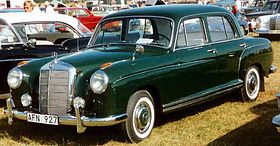 | |
| Overview | |
| Also called | 220a/220S/220SE |
| Production | 1954–1957 (W180) 1958–1961 (W128) |
| Body and chassis | |
| Layout | FR layout |
| Powertrain | |
| Engine | 2.2L I6 |
The W180 line debuted in 1954, and is the first lineup of "Ponton" models associated with the Mercedes-Benz S-Class. The W180 featured six-cylinder sedan, coupé, and convertible models, and was produced until 1957. The later W128 lineup, introduced in the mid-to-late 1950s, was the last to be associated with the "Ponton" name. It featured the 220a, 219 (W105), 220S, and 220SE models (sedan, coupé, and cabriolet) powered by a 2.2L straight-6, and came to ten. The "Ponton" designation referred to pontoon fenders, a stylistic feature on the W180/W128 models.

The "Ponton" lineup included four- and six-cylinder models, but only the six-cylinder W180 and W128 lines are considered part of the Mercedes-Benz S-Class chronology, as they were the most powerful "Ponton" versions available. Both "Ponton" models were Mercedes' first without a conventional frame, using a unitized body/frame construction.
"Fintail" (1959)
| W111/W112 | |
|---|---|
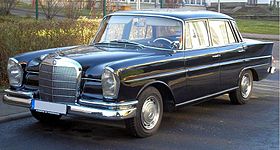 | |
| Overview | |
| Also called | 220/220S/220SE/230S/250SE/280SE/280SE 3.5 |
| Production | 1959–1968 (sedan) 1961–1971 (coupe and cabriolet) |
| Body and chassis | |
| Layout | FR layout |
| Powertrain | |
| Engine | 2.2 L I6 2.3 L I6 2.5 L I6 2.8 L I6 3.5 L V8 |
Mercedes Benz Fintail (German: Heckflosse) is a nickname given to certain Mercedes Benz vehicles which show American influences in design including the presence of tailfins. Though never officially designated as such (they were designated Peilstege, marking the end of the car in rear view mirror). The Fintail series replaced the Ponton series.
The exterior was designed for the European and North American markets. The body was modern and featured a characteristic tailfins that gave the models their nickname — the fintail (German: Heckflosse).
The W111 was a chassis code given to its top-range vehicles, including four-door sedans, produced from 1959 to 1968, and two-door coupes and cabriolets from 1961 to 1971. The W111, was initially attributed only to six-cylinder cars with 2.2-litre engines. The luxury version with big-block 3-litre engines were given the chassis code W112. The entry-level vehicles with four-cylinder engines were called W110. All three versions W110, W111, and W112, in both two- and four-door bodies, were built on an identical chassis.
W108 (1965)
| W108 & W109 | |
|---|---|
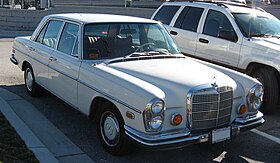 | |
| Overview | |
| Also called | 250S/SE/280S/SE & 300SE |
| Production | 1965–1972 |
| Body and chassis | |
| Layout | FR layout |
| Powertrain | |
| Engine | 2.5 L I6 2.8 L I6 3.0L I6 3.5 L V8 4.5 L V8 6.3 L V8 |
With "Fintails" being passé and dropped in favor of a look similar to the 600, the updated and larger W108/W109 lines were introduced in 1965. With the W108/W109 series, the range received V8 power for the first time (from 1969). The W108 line launched with an initial lineup of straight-six powered models using the M129, 2.5-liter engine. The unusual high-displacement 300 SEL 6.3 V8 model was based on this body type. The W108 line, which included the 250S, 250SE, 280S 280SE and 280SEL (long-wheelbase) models, was larger than the Fintail models it replaced, and also eliminated the characteristic design feature of the previous model.
During this period, the designation S or SE was used for short-wheelbase models including 250S, 250SE, 280S, 280SE and 300SE. The "E" stands for the German word "Einspritzen" which was a reference to the vehicle being equipped with fuel injection for the engine. Vehicles without the E designation as part of the model number or nomenclature retained the carburetor setup. Long-wheelbase models (extended by 10 centimeters in the rear doors) were designated SEL (L= lang or long). Since the advent of the W108 series, the Mercedes-Benz S-Class has always included two wheelbase lengths, although not all wheelbases are sold in every country. The 300 SE and 300 SEL models were classified as W109 chassis and had front and rear air suspension compared to coil spring based rear suspension of W108 models. The more powerful 300SE and 300SEL models were the most luxurious versions of the W108 line, with available burl walnut interior trim, automatic transmission, and power windows.
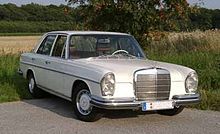
In 1968, the W108 line dropped the 250SE in favor of S-Class models with the larger-engined 280S (in carbureted form) and the 280SE (with fuel injection); the 250 S model was built some two years longer as an entry model until 1969; the 300SE/SEL models had the gasoline guzzling three litre six-inline engine dropped, got intermediate the 2.8 litre engine of the SL type (W113), and were later offered with a 3.5-litre V8 engine (in both the SE and SEL form, not in the U.S.) and 4.5-litre (U.S. only) and 6.3-litre V8 engines (in the SEL model only). The W108/109 lines, which eventually supplanted the W111 lines, were not available with four-cylinder engines, and thus established the distinct S-Class market position at the time consisting of I-6 and V-8 engines. That business model has since been updated, at least in non-US markets.
S-Class models
W116 (1972-1980)
| W116 | |
|---|---|
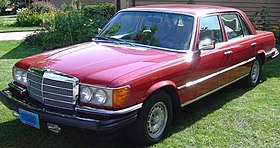 | |
| Overview | |
| Also called | 280S/SE/SEL, 350/450SE/SEL, 300SD |
| Production | 1972–1980 |
| Body and chassis | |
| Layout | FR layout |
| Powertrain | |
| Engine | 2.8 L I6 3.5 L V8 4.5 L V8 6.9 L V8 3.0 L I5 turbodiesel |
| Transmission | 3-speed automatic 4-speed automatic 5-speed manual |
In 1972, Mercedes-Benz introduced the W116 line, the first to be officially called the S-Class.[3] Produced from 1972 through 1980, the W116 series featured a four-wheel independent suspension and disc brakes. The 280, 350, and 450 (4.5L version) models featured SE and SEL versions. Production of the W116 totaled 473,035 units. This was a groundbreaking sedan for Mercedes-Benz, and for the first time in the company history, the car had an obvious, blatant and outward emphasis on safety placed above a pure styling viewpoint. The overall design incorporated numerous safety features developed from the "safety research vehicles" in the mid-to-late 1960s to the very early 1970s.
These safety features were all newly introduced passenger-car "firsts" on a production vehicle: padded door trim around the windows, heavily padded steering wheel (later to be replaced by an airbag with the Mercedes-Benz abbreviation of SRS standing for the English-language term Supplemental Restraint System), more comprehensive safety padding on the dashboard and around the interior, dual asymmetric windshield wipers, headrests with a center depression to locate the occupant's head in a more central position during a rear impact, a rain-water management system to improve visibility consisting of deep channels on both sides of the windshield and flowing into deeply channeled rain gutters, including similar designs on the side mirrors, rounded body shapes along the edges, such as the tops of the front fenders, etc., designed to ameliorate pedestrian injuries, ribbed rear taillamp lenses which would remain clearer of dirt on the recessed areas, an easy-to-access first aid kit stowed in a recessed compartment on the rear parcel shelf prominently labeled with the universally recognized "cross" symbol which represents "first aid", and several other subtle safety features related to both active and passive safety.
The W116 models were large luxury sedans. The W116 was larger on the outside than the W108/W109 series it replaced, but had similar interior capacity, as the additional bulk was driven by several new and aforementioned engineering developments on car safety and occupant protection in a crash. The W116 introduced other improved passive safety features into the vehicle design, including a strengthened vehicle occupant shell. It was one of the first cars to be available with ABS, a driver's airbag supplemental restraint system (but not available at the vehicle's initial launch), and the first appearance of a turbocharger for the diesel engine.
The 450SE, then the most powerful model in the W116 lineup, was awarded European Car of the Year in 1974. At the New England Auto Show in 1972 held in the fall season in Boston, the Munroney Label (window sticker) of a 1973 450SE was right at $13,000. 1973 was the first model year of the W116 for the US market. Starting in 1975, the W116 was upgraded with a new fuel injection system to comply with revised exhaust emission standards in European markets. A slight power reduction was a result of this update, but in 1978, a series of further engine upgrades restored original performance levels under the new fuel injection systems. Between 1973 and 1977, 997 Special Edition W116 models were made on order by Mercedes. These cars incorporated stronger body paneling and suspension and was 50 kg heavier than its normal counterpart.
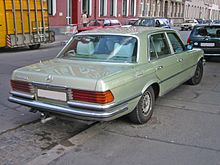
Engines
With the W116 models, the V8-engines of the 350/450 SE/SEL models were now regular options. Due to the oil crisis, fuel efficiency was the major concern for the engineers, yet they still added also the high-performance, limited-production 450 SEL 6.9. This 8-cylinder model, affectionately referred to as simply "the 6.9", boasted the largest engine installed in a postwar Mercedes-Benz up to that time. Every 450 SEL 6.9 featured a self-leveling hydropneumatic suspension, and offered the ABS anti-lock braking system as an option from 1978 onwards. Also, in the United States and Canada only, Mercedes-Benz introduced the economical but powerful 3.0-liter 5-cylinder turbodiesel in 1978, sold as the 300SD.
W126 (1979-1991)
| W126 | |
|---|---|
 | |
| Overview | |
| Also called | 260/280/300/380SE/SEL, 420/500/560SE/SEL/SEC, 300/350SD/SDL |
| Production | December 1979—April 1992 |
| Body and chassis | |
| Layout | FR layout |
| Powertrain | |
| Engine | 2.6 L straight-six 2.8 L straight-six 3.0 L straight-six 3.5 L straight-six 3.8 L V8 4.2 L V8 5.0 L V8 5.6 L V8 3.0 L 5-cylinder turbodiesel 3.0 L 6-cylinder turbodiesel 3.5 L 6-cylinder turbodiesel |
| Transmission | 4-speed automatic 5-speed manual |
The W126 series premiered in late 1979 as an 1980 model, and in March 1980 as an 1981 model in the USA and Australia replacing the W116 line. The W126 line featured improved aerodynamics and enlarged aluminum engine blocks. In 1981, the W126 S-Class won the Wheels magazine (Australia) Car of the Year award. The W126 was manufactured from 1979 through 1991 with a mid-cycle update. Coupé models based on the S-Class were reintroduced with the W126 (380/500 SEC). Total sales of the W126 S-Class sedans reached 818,036 units, with an additional 74,060 coupes sold.

In 1981, the W126 introduced the modern airbag, as patented by Mercedes-Benz in 1971, as well as the passenger side airbags (in 1988), seat-belt pretensioners, and traction control. The interior featured additional courtesy and reading lamps, along with heated seats and a more advanced climate control system. A four-speed automatic transmission was standard.
Although the top of range Mercedes-Benz 450SEL 6.9 of the previous generation was not directly replaced, the W126 carried forward the hydropneumatic suspension of the 6.9 as an option on the 500SEL. A new cruise control system was offered as well. Succeeding the roadster based coupes, the W126 introduced a two-door variant, the SEC coupé. The W126 S-Class received a mid-cycle update in 1986 with exterior modifications and engine upgrades occurred.

Engines
Powerplants on the W126 S-Class included straight-6 and V8 engines. Most sales came from the diesel model in the United States and straight-six models in Europe, although the V8 models were praised by contemporary journalists. During the W126 mid-cycle update in 1986, both the straight-6 and V8 engines were upgraded in several models to different displacement levels (six-cylinder upgraded from 2.8 L to 3.0 L, eight-cylinder upgraded from 3.8 L to 4.2 L, and 5.0 L to 5.6 L).
W140 (1991-1998)
| W140 | |
|---|---|
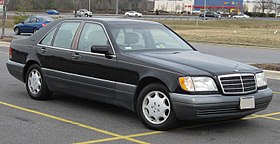 | |
| Overview | |
| Also called | 300SE/SEL, 400/500/600SEL, 500/600SEC, 300SDL, 350SDL |
| Production | April 1991–August 1998 |
| Body and chassis | |
| Layout | FR layout |
| Powertrain | |
| Engine | 2.8 L 197 hp (147 kW) I6 3.2 L 228 hp (170 kW) I6 4.2 L 275 hp (205 kW) V8 5.0 L 330 hp (250 kW) V8 6.0 L 408 hp (304 kW) V12 M120 (1991–1993) 6.0 L 389 hp (290 kW) V12 M120 (1994–1999) 3.0 L Turbodiesel 177 hp (132 kW) I6 3.5 L Turbodiesel 148 hp (110 kW) I6 |
| Transmission | 4-speed automatic 5-speed automatic 5-speed manual |
In 1991, the W140 series replaced the W126 line with the first production model assembled on August 6 of that year.[citation needed] The W140 grew in proportions and featured two wheelbase lengths and a shorter-wheelbase W140 coupé. Production totalled 432,732 units.[citation needed]

The W140 cost 25% more than the W126 it replaced and featured double-pane window glazing, self-closing boot lid and doors, electric windows with a jam-protection feature (lowering when encountering an obstruction), rear-parking markers in the US (which appeared on the rear wings when in reverse), and a heating system which emitted warm air while residual energy was available after the engine was turned off.

In 1993, Mercedes-Benz model nomenclature was rationalized, with the SE/SEL/SEC cars becoming the S-Class and alphanumerical designations inverted (e.g. the both 500SE and 500SEL became S500 regardless of wheelbase length). In 1995, the W140 received a minor facelift featuring clear turn signal indicator lenses on the front and rear as well as headlamps fitted with separate low- and high-beam reflectors for the US market. Following the mid-year facelift, the W140 coupé and sedan (Saloon) featured Electronic Stability Control.
W220 (1999-2005)
| W220 | |
|---|---|
 | |
| Overview | |
| Also called | S280, S320, S420, S350, S430, S500, S600, S320 CDI, S55, S63, S65 |
| Production | August 1998–July 2005 |
| Body and chassis | |
| Layout | Front engine, rear-wheel drive / four-wheel drive |
| Powertrain | |
| Engine | 2.8 L 204 hp (152 kW) V6 3.2 L 224 hp (167 kW) V6 3.2 L 197 hp (147 kW) I6 diesel 3.7 L 245 hp (183 kW) V6 4.0 L 250 hp (190 kW) V8 diesel 4.3 L 279 hp (208 kW) V8 5.0 L 306 hp (228 kW) V8 5.4 L 493 hp (368 kW) V8 5.8 L 367 hp (274 kW) V12 5.5 L 493 hp (368 kW) V12 6.3 L 444 hp (331 kW) V12 6.0L 604 hp (450 kW) V12 |
| Transmission | 5-speed automatic and 7-speed automatic (7G-Tronic) |
In July 1998, the W220 was introduced. The W220 S-Class was completely restyled, with a body that was slightly smaller and lighter than its predecessor. Unlike its predecessor, the W220 was not the first model to feature the company's new design theme for the next generation of Mercedes-Benz. This honor was given to the A-Class when it launched in 1997. The new S-Class incorporated the new styling cues first introduced on the Mk I A-Class the year before (for example, the dashboard carried over the new styling details first seen in the A-Class), with a renewed focus on elegance and style in a more rounded shape compared to the preceding W140. Despite being smaller, the W220 S-Class offered more interior space than the W140. Production of the W220 S-Class totaled 485,000 units, slightly more than the production totals from the W140. The W220 was produced in a sedan version only.[4]
As with each new S-Class, the W220 brought in innovations such as Airmatic air suspension and Active Ventilated Seats (which used miniature fans in the seats to move air through perforations). A navigation system with center console-mounted screen display was introduced, along with the COMAND input control system. Other options included keyless entry and ignition, a radar-controlled Distronic cruise control system and a cylinder shut-off system called Active Cylinder Control. The 4MATIC all-wheel drive system was introduced to the North America market S-Class for 2003, complementing the traditional rear-wheel drive configurations.

While Consumer Reports classified the W220 model's reliability as "poor," its lowest rating, and declared it one of the "least reliable luxury cars,"[5] Edmunds gave the S-Class a 5 out of 5 reliability rating[6] and MSN Autos assign an expert rating of 9.0 out of 10.[7] By March 2011, Consumer Reports had changed its reliability ratings for the 2001 and 2002 S-Class as having improved to "average". Build quality was generally considered to be good. For instance, Forbes described the W220 S500 as "built remarkably well."[8] Early W220s were recalled for issues with the trunk spring and the hydraulic fuel line; there were no recalls for the 2005 or 2006 model years.
In 2002, Mercedes-Benz introduced the world's first preemptive safety system on the W220 with its first iteration of Pre-Safe. The W220 S-Class received an exterior refresh with updates to the front fascia. The grille angle was adjusted to a slightly more upright position, and the xenon-discharge headlamps were given a new transparent housing, replacing the earlier opaque versions. The front bumper's lower air intakes were also restyled. In 2005, the S-Class was the first vehicle to receive a TÜV Institute environmental certificate from the German Commission on Technical Compliance for environmentally friendly components.[9]
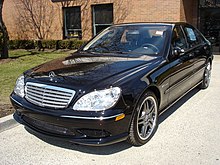
Engines
The W220 was available with more engine options than the W126 or W140. The range started with smaller 3.2L 224 hp (167 kW) V6 motor, which was superseded by an enlarged 3.7 L 245 hp (183 kW) V6 in the S350. The S430 was powered by a 4.3 L 279 hp (208 kW) V8 and the S500 was powered by a 5.0 L 306 hp (228 kW) V8. The S55 AMG was outfitted with a supercharged 5.4 L 493 hp (368 kW) V8 motor, the S55 AMG 2000/2001 was outfitted with the naturally aspirated 5.4 L 367 hp (274 kW) V8 motor. The S600 was outfitted with a 5.5 L 493 hp (368 kW) V12 twin turbo engine, the S600 2000/2001 was outfitted with the naturally aspirated 5.8 L 367 hp (274 kW) V12 engine.
For one month in 2001, AMG produced the S63 AMG, which was sold in very limited numbers. The S63 was powered by a 6.3 L 444 hp (331 kW) V12. An undisclosed number of them were sold exclusively through AMG in European and Asian markets. A handful of the S600 AMG "collectors edition" were produced in the later years of the W220, much the same specs as the S63 AMG, but with an improved interior and voice command. The S600 AMG were one of the earlier models to be introduced with the Euro 4 emissions system. The S65 AMG was introduced in 2003 and went on sale in 2004 as a 2005 model. Powered by a 6.0 L 612 horsepower (456 kW)* V12 twin turbo motor, the S65 was the most powerful S-Class, as well as the world's most powerful production sedan. The S65 had a 0 to 60 mph (0 to 97 km/h) time of 4.2 seconds (conservative MB estimate) and an owner-tested time of 3.8 seconds and could reach 100 mph (160 km/h) under 9 seconds. Furthermore, a simple software upgrade pushes the engine to 740 hp and well over 850 ft/lbs tq.
W221 (2005-2013)
| W221 | |
|---|---|
 | |
| Overview | |
| Also called | S250 CDI, S300, S350 (BlueEFFICIENCY, BlueTEC), S400 HYBRID, S450, S550(500), S600, S320/S420 CDI, S63, S65 |
| Production | 2005-2013 |
| Model years | 2006-2013 (Europe) 2007-2014 |
| Body and chassis | |
| Layout | Front engine, rear-wheel drive / four-wheel drive |
| Related | Mercedes-Benz CL-Class |
| Powertrain | |
| Engine | 2.1 L diesel 204 hp (152 kW) I4 2.1 L diesel 204 hp (152 kW) I4 |
| Transmission | 7-speed (5-speed on S65 & S600) automatic |
| Dimensions | |
| Wheelbase | SWB: 3085 mm LWB: 3165 mm |

The all-new W221 was introduced in the autumn of 2005 at the Frankfurt International Motor Show, with sales starting in autumn of 2005 and export to other markets beginning in 2006. The W221 S-Class made its North American premiere at the 2006 North American International Auto Show in January. The latest S-Class is slightly larger in all dimensions than its predecessor, and it features three newly developed engines with up to 26% power increase. The interior is completely new, all materials have been upgraded and make for a more luxurious ride, and the center console transmission gear lever has been replaced with a column-mounted shifter. New technological features on the W221 include an infrared Night View Assist feature and the latest Mercedes-Benz pre-collision system. The W221 features sharper exterior styling (most notably wide fender arcs) and technological improvements. The W221 is the second consecutive generation of the S-Class to be solely produced in a sedan body style.
Models sold in North America are the S450 (2008-, SWB and Canada only), S400 Hybrid (2010- ), S350 Bluetec 4MATIC (2012- ), S550, S600, S63 AMG and S65 AMG; other models to be sold outside North America include the S280, S350, S300, S420 CDI and S320 CDI. The first W221 model released in North America and Japan was the S550 (called S500 outside North America and Japan), with the S600 arriving in the following spring.[10][11] Mercedes Benz Mexico also produces a police spec model of the S-600, the S-600P. The S-600P is similar to the standard S-600 but is equipped with the dual turbo charged V-12 engine of the S65 AMG and includes police lights, siren, run-flat tires, a gun mount, a Lanix computer station integrated with the host police network, optional prisoner cage and restraint seats, and level B6/B7 armoring. The S-600P is only built in Mexico and only comes in long-wheelbase version. The Mexican government uses S-600P's mainly for transporting important figures, but several police departments in wealthier cities in the country use them as patrol vehicles, as does the Mexican Federal Police in limited numbers. A small number of S-600P were purchased by the police department of Guangzhou, China for protection of key government figures.

In the US for the 2010 model year, the S-Class received a facelift across the entire model line in mid-2009. Daytime LED running lights were fitted to the outer edges of the bi-xenon lamp units. The rear end was accented with a total of 52 distinctively arranged LEDs in the two taillights. Gone are the body-colored strips through the tail lamps. Other noticeable changes at the front of the car are a more pronounced arrow-shaped grille, plus a new front bumper with a light-catching contour and a chrome strip below the cooling air intakes. New, sleeker rear-view door mirrors with LED turn signals were also added. Exhaust tailpipes of all S-Class variants were visibly integrated into the rear bumper. The wheels were updated to more modern-style ones. Also new is a S400 Hybrid version. Safety also improved on most Mercedes Benz models, with the orange-colored light reflectors mounted on the side of the bumpers. Also, before it was updated it had a C-Class look at the front. Afterwards it disappeared. Also, some shiny chrome is added to the bottom of the doors and bumper.[12]
In terms of performance, the S550 completes the 0–60 mph run in just 5.4 seconds. Despite having a weight of 2304 kg, the S65 AMG still makes it 0 to 60 in just 4.2 seconds.[13] The S 63 AMG and the S600 makes the same sprint in about 4.6 seconds. Mercedes-AMG claim that the S63 will pull from 50 mph to 70 mph in around 3.9 seconds while the S65 make it from 50 mph to 70 mph in 3.6 seconds.

The brakes continue to become more advanced with the new Brake Assist Plus system monitoring for an impending collision and increasing braking if needed, while the Distronic Plus radar guided cruise control can now bring the car to a complete stop.[14] This system works in outdoor conditions; a test demonstration by Mercedes-Benz in a crash-test hall resulted in embarrassment for the company when a new S-Class crashed into the back of a stationary W220 S-Class. This incident was later attributed to the radar system malfunctioning inside the radar-reflective (i.e. radar-confusing) steel test building where the event was filmed.[15]
Upscale department store Saks Fifth Avenue offered 20 special-edition S600 sedans for sale in its 2005 Christmas catalog. All 20 cars, priced at US$145,000 each, sold on November 22, 2005 in under seven minutes. The Saks-edition S600 sedans were finished in a mocha black exterior with an almond beige interior and were the first examples of the S600 to be sold to private owners. The S600s came with nearly every option standard. In 2007, Automobile Magazine named the W221 S-Class as one of its 2007 "All-Stars" over rivals from Lexus and BMW,[16] and Car and Driver selected the S550 as the winner in a five-way comparison test of flagship luxury sedans,[17] as did Motor Trend Magazine in July 2009 in a three way comparison test, with the other two competitors being the BMW 750Li, and Audi A8L 4.2 Quattro. The W221 S-Class was also the recipient of several other motoring awards (see following).
W222 (2013-present)
| W222 | |
|---|---|
 | |
| Overview | |
| Production | 2013- |
Officially unveiled in May 2013, the newest S-Class has more streamlined appearance than the outgoing model. Some interesting features include a large front grille inspired by the F700 Concept car and LED lights used exclusively inside and out - a first in the automotive industry.
Two strong converging character lines give the flanks a more sculpted look, while integrated exhaust tips and a large glass roof (likely optional) highlight the design. Inside, almost every surface is covered by a 'luxury' material - everything that looks like leather is genuine leather and metal is used rather than any plastic alternative. The instrument cluster consists entirely of two widescreen (30.5 cm diagonal) LCD displays with animated graphics. A 'Head-Up' display and gesture responsive touch pad will become options in 2014.
The W222 debuts the available 'Magic Body Control', consisting of windshield mounted cameras that can 'read' the road ahead and communicate with the suspension to ready it for an uneven road surface. Initially only available on 8-cylinder models and above, Magic Ride Control attempts to isolate the car's body by predicting rather than reacting to broken pavement and speed humps.
Available luxury appointments over and above what was offered in the W221 include a choice of massage type for each seat occupant (the W221 offered various intensities of a single massage type) and two levels of premium audio from luxury German brand, Burmester.
The W222 S Class comes closer than any production car to having the ability to drive autonomously. Systems aboard the W222 allow it to steer a course within a lane and follow a leading vehicle for a short period. It will also slow or come to a dead stop and accelerate in response to traffic ahead. Mercedes engineers claim to have, under controlled conditions, ridden aboard a W222 S Class that has driven autonomously for 50 km, merely by altering parameters controlling equipment already fitted.
Like the W221 S500, the W222 S-Class will be powered by a more powerful twin-turbo V8 producing 455 hp (339 kW) while the S600 will carry a twin-turbo V12. There is also a diesel-powered S350 BlueTEC version, a hybrid S400 with a 20-kilowatt electric motor and 306 hp (228 kW) V6 engine, and a diesel-electric hybrid S300 BlueTEC. AMG fettered S63 (V8 bi-turbo) and S65 (V12 bi-turbo) LWB sedans are also on offer. All S-Class models will come with a 7-speed automatic transmission.[18]
Along with the sedan, the S-Class will spawn a coupe and convertible as well as an extended-wheelbase 'Pullman' variant, longer than the long wheelbase 'L', that will fill the Maybach void. While the short-wheelbase model carries chassis code W222, the long-wheelbase model uses chassis code V222. Unlike with previous generations, Mercedes focused primarily on the development of the longer model as many customers in the fast growing Asian markets prefer to be chauffeured.[19]
Autobahn use
Large stretches of the German Autobahn network do not feature any speed limit except a recommended 130 km/h (81 mph). Driving at rather high speeds for extended periods tends to result in increased strain on a vehicle and requires careful engineering. Mercedes-Benz has sought to engineer its vehicles, most notably the S-Class, to excel in this unique environment and allow high speed cruising. [citation needed] Specific standards of engine performance, body integrity, and reliability are part of this process. The S-Class is built with an electronically limited top speed of 250 km/h (155 mph) which drivers can maintain when driving on the autobahn. AMG Manufaktur offer delimitation to allow speeds of 300 km/h (186 mph).
Historically, the engineering of the S-Class was claimed to have been designed without regard to cost, a practice which continued unfettered up through the W140 line.[citation needed] The company in turn has been able to exploit this as a marketing tool, culminating in its onetime slogan, "engineered like no other car in the world." This slogan was used throughout the 1980s with the marketing of the W126 S-Class, however, following the formation of DaimlerChrysler and the cessation of engineer-sanctioned overbudgeting in the late 1990s, this slogan was dropped. The subsequent W220 model S-Class were reported to suffer from relatively lower reliability and quality rates to previous models.[20]
Concept cars
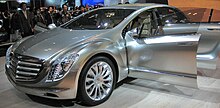
In the 1980s, Mercedes-Benz built the world's first driverless cars using the S-Class, together with the team of Professor Ernst Dickmanns at Bundeswehr Universität München.[21] The culmination of this effort was achieved in 1995, when Dickmanns' re-engineered autonomous S-Class robot completed a trip from Munich, Bavaria to Copenhagen, Denmark and back. On the autobahn, the robot S-Class achieved speeds exceeding 175 km/h. It suggested and executed overtaking maneuvers. The car's abilities left a big impression on many observers, and is said to have heavily influenced robot car research and funding decisions worldwide.
A concept future hybrid, the F700 research car, was also unveiled at the 2007 Frankfurt Motor Show.[22] The F700 featured three regular opening doors and a fourth door capable of 180-degree rotation. Also comes with bulletproof and puncture-resistant tyres.
Safety
Mercedes-Benz has traditionally introduced its safety innovations in the S-Class. For instance, the S-Class was the first car in Europe to incorporate airbags. S-Class safety features included innovations in active safety (accident avoidance), passive safety (collision protection), and holistic safety (integration of both active and passive safety features). Active safety features include: ABS braking in 1978 (acts to reduce braking distances and improve stopping control; co-developed with Bosch); traction control and Electronic Stability Program (ESP) in 1995 (improves driver control during difficult road conditions); and Brake Assist (provides full braking power during emergency stops). In 2005, a new infrared night vision feature was introduced (improves visibility during nighttime conditions). Despite the popular misconception, the S-Class was not the first car fitted with ABS braking technology, although some credit can be given for popularizing this now largely standard feature (ABS was initially an option on most models of the W126 S-Class).
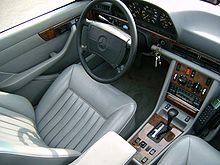
Passive safety features include: crumple zones in 1957 (vehicle body structure absorbs the force of impact); collapsible steering column (prevents the steering column from protruding into the cabin during accidents), strengthened occupant cell enhanced occupant protection during severe impacts (rollovers); pre-accident seatbelt tensioning (tightens seatbelts prior to impact), and sandwich platforms (allows the engine to slide under the occupants in a head-on collision).
PRE-SAFE, Mercedes-Benz's holistic safety feature, was introduced on the S-Class in 2002. PRE-SAFE integrates multiple active and passive safety features for a "safety net" approach to vehicle safety by attempting to prevent accidents; if accidents do occur, PRE-SAFE aims to reduce occupant injury. In the latest version of this pre-collision system, PRE-SAFE will prime the brake assist system, lock the doors to prevent accidental opening during the accident, adjust the seats, close the windows and sunroof, and tighten seatbelts during certain types of collisions. In the event an accident results in a roll over, the PRE-SAFE feature unlocks the doors and lowers the windows approximately one half-inch to allow you to exit or safety workers to gain access easily.
Road accident statistics on a model-by-model basis from the UK Department of Transport show that the Mercedes-Benz S-Class is one of the safest cars on the UK roads[citation needed] (measured in terms of chance of death in an accident).
S-Guard
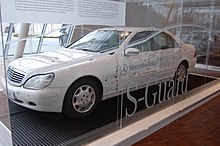
A special armored version of the Mercedes-Benz S-Class has been produced, known as the S-Guard. Features include the capability to withstand military-grade small arms fire and certain explosive devices, a self-sealing fuel tank, and an alarm system.[23] For 2009, Mercedes-Benz launched a long-wheelbase version of the S-Guard, known as the Pullman Guard. This model is 45 centimeter longer than the standard model and also has a higher roof and taller rear window with a different rake.[24]
The S-Guard is widely used at the diplomatic level to protect world leaders. Ninety governments worldwide are known to use the S-Guard for transport of government leaders and dignitaries.[25] The S-Guard is built on a special production line at the S-Class facility in Sindelfingen, Germany, with specific S-Guard enhancements integrated at multiple stages throughout the production process.[25]
Production
Most S-Class models, including the W221, are built at the Daimler AG plant in Sindelfingen, Germany and at the Mercedes-Benz-Valdez plant in Santiago Tianguistenco, Mexico. Founded by Daimler Motoren Gesellschaft in 1915, the Sindelfingen plant also produced the model 600 "Grosser Mercedes" and past generations of the S-Class.[26] Previous S-Class models (such as the W126) were built in different locations ranging from Stuttgart to South Africa, but with recent models (such as the W220) production has been concentrated in Sindelfingen and Santiago Tianguistenco. In February 2007, DaimlerChrysler Malaysia's (now, Mercedes Benz Malaysia) plant in Pekan, Pahang began production of S350 (model W221) vehicles and is currently assembling S300, S350L and S500L.[27] In all, some 2.7 million S-Class vehicles have been produced in the past forty years.[28]
- W116: 473,035
- W126: 818,036
- W140: 406,532
- W220: 485,000
- W221: 85,900 ('06),[29] 85,500 ('07),[29] 90,600 ('08),[30] 53,400 ('09),[31] 66,500 ('10)[32] 68,969 ('11), 65,128 ('12)
Sales
| Calendar year | US (hybrid) | Germany | China |
|---|---|---|---|
| 1999 | 22,966 | ||
| 2000 | 21,266 | ||
| 2001 | 25,998[33] | 18,347 | |
| 2002 | 21,118 | 11,395 | |
| 2003 | 22,940[34] | 9,865 | |
| 2004 | 20,460 | 7,045 | |
| 2005 | 16,036[35] | 6,718 | |
| 2006 | 30,886 | 10,985 | |
| 2007 | 26,081[36] | 8,262 | |
| 2008 | 17,787 | 8,077 | |
| 2009 | 11,199[37] () | 6,617 | |
| 2010 | 13,608 (955)[38] | 5,177 | 25,000[39] |
| 2011 | 12,258[40] | 4,730 | 31,050[41] |
| 2012 | 11,794 | 3,304 | 33,140 |
| 2013 | 13,303 |
Awards
Notable examples of awards received by the Mercedes-Benz S-Class include the top ranking in the J.D. Power Sales Satisfaction Index from 1987 to 1990,[42] seven time ranking as What Car? "Best Luxury Car",[9] and five times as Fleet News "Luxury Car of the Year".[9] The S-Class was Wheels Magazine Car of the Year for 1981 and 1999,[43] U.S. Highway Loss Data Institute "Safest Passenger Car of the Year" in 1988 and 1989,[44] and European Car of the Year in 1974. The S-Class is also the first car ever (2005) to receive an environmental certificate from the German Commission on Technical Compliance (TÜV).[9] Other awards range from Popular Science Best of What's New—Grand Award 2005[45] to Top Gear magazine's "Limousine of the Year" for 2006.
References
Notes
- ^ "Mercedes 2005 S-Class to Keep Rivals Honest". Webwombat.com.au. 2005-05-30. Retrieved 2010-10-09.
- ^ "New Merc S-class goes hi-tech". Motoring.co.za. Retrieved 2010-10-09.
- ^ Silva, Bruno (ed.). "Mercedes S Class Paternity". BCG. Retrieved 2013-01-20.
- ^ "Consumer Guide. 2004 Mercedes-Benz S-Class/CL-Class Snapshot". Retrieved 2003-12-21.
- ^ Taylor, Alex (2006-11-20). "Consumer Reports - Mercedes W220 S-Class reliability". Money.cnn.com. Retrieved 2010-10-09.
- ^ "Edmunds, S-Class reliability". Retrieved 2012-05-26.
- ^ "MSN Auto S-Class reliability rating". Retrieved 2012-05-26.
- ^ Elliott, Hannah. "Forbes Mercedes-Benz W220 S-Class test drive". Forbesautos.com. Retrieved 2010-10-09.
- ^ a b c d "S-Class Voted Fleet News Luxury Car of The Year For Fifth Time". Theautochannel.com. Retrieved 2010-10-09.
- ^ by A Yahoo! Autos User (2009-08-19). "Yahoo Auto S-Class S550 official MSRP". Autos.yahoo.com. Retrieved 2010-10-09.
{{cite web}}:|author=has generic name (help) - ^ Yahoo Auto S-Class S600 official MSRP[dead link]
- ^ [1][dead link]
- ^ "2007 Mercedes-Benz S65 AMG How to scare your passengers". Retrieved 2012-10-02.
- ^ "Forbes Auto. "Smooth Sophisticate"". Retrieved 2007-03-13.
- ^ "Technology Failure Embarrasses Mercedes". Autospies. Retrieved 2010-10-09.
- ^ "All-Star 2007 Mercedes-Benz S-class". Automobilemag.com. Retrieved 2010-10-09.
- ^ "Chauffeur Showdown". Car and Driver. Retrieved 2010-10-09.
- ^ "New Mercedes-Benz S-Class Highlights Enhanced Power in Luxury". Automoblog.net. Retrieved 2013-05-16.
- ^ Jens Meiner (15 May 2013). "2014 Mercedes-Benz S-class: "Effortless Superiority"". Car & Driver. Hearst Corporation. Retrieved 16 May 2013.
- ^ Taylor III, Alex (November 17, 2006). "CNN Money. "Mercedes Vs. Consumer Reports"". Retrieved 2007-04-16.
- ^ Highlights of robot car history with emphasis on S-Class robot car of 1995 by Ernst Dickmanns by Jürgen Schmidhuber, 2005
- ^ "Newsday - A hybrid drives Mercedes concept". .lexisnexis.com. Retrieved 2010-10-09.
- ^ "Mercedes Introduces Armored S-Class". Theautochannel.com. Retrieved 2010-10-09.
- ^ "2009 Mercedes-Benz S600 Pullman Guard - Auto Shows". Caranddriver.com. Retrieved 2010-10-09.
- ^ a b Mercedes-Benz S-Guard: the car of steel[dead link]
- ^ DaimlerChrysler - Home - Corporate Profile - Worldwide Locations - Sindelfingen Plant:
- ^ Tan, Paul. "Malaysia to get locally assembled S-class next year". Paultan.org. Retrieved 2010-10-09.
- ^ "Mercedes-Benz S-Class Looks Back on a Success Story: 220 Series Is World's Best-Selling Luxury Sedan". Autointell.com. Retrieved 2010-10-09.
- ^ a b "Mercedes-Benz Cars steigert Absatz 2007 auf ... (zwei) 08.01.2008 | Nachricht". finanzen.net. 2008-01-08. Retrieved 2011-10-23.
- ^ "Daimler AG | Mercedes-Benz Cars liefert im Jahr 2008 weltweit 1.256.600 Fahrzeuge aus | Pressemitteilung | Pressemeldung". Pressrelations.de. Retrieved 2011-10-23.
- ^ "Mercedes-Benz Baureihe 221 – Wikipedia" (in Template:De icon). De.wikipedia.org. Retrieved 2011-10-23.
{{cite web}}: CS1 maint: unrecognized language (link) - ^ "Erfolgsjahr für Mercedes-Benz: Weltweites Absatzplus von 15 Prozent in 2010 | Daimler > Unternehmen > Nachrichten". Daimler. Retrieved 2011-10-23.
- ^ "Mercedes-Benz USA Records Highest Sales in Its History. - Free Online Library". Thefreelibrary.com. 2003-01-03. Retrieved 2011-10-23.
- ^ "2004 Highest Year on Record for Mercedes-Benz USA". Theautochannel.com. Retrieved 2011-10-23.
- ^ "Mercedes-Benz Rings in the New Year with Record 2006 Sales". Theautochannel.com. Retrieved 2011-10-23.
- ^ "Mercedes-Benz USA's Sales Drop 32.1 Percent In December 2008". Emercedesbenz.com. 2009-01-05. Retrieved 2011-10-23.
- ^ "Highest Sales Month for the Year at 21,469 Brings Mercedes-Benz to an... - MONTVALE, N.J., January 4, 2011 /PRNewswire/". New Jersey: Prnewswire.com. Retrieved 2011-10-23.
- ^ "December 2010 Dashboard: Year End Tally". Hybrid Cars. 2011-01-07. Retrieved 2011-10-23.
- ^ "Mercedes-Benz China Homepage - 2011 News - 115% Growth - Mercedes-Benz Remains China's Fastest Growing Premium brand in 2010". Mercedes-benz.com.cn. Retrieved 2011-10-23.
- ^ "Mercedes-Benz Records the Highest Year on Record with Sales of 264,460 - MONTVALE, N.J., Jan. 5, 2012 /PRNewswire/". New Jersey: Prnewswire.com. Retrieved 2012-05-18.
- ^ "Mercedes-Benz China Homepage - 2012 News - Mercedes-Benz completes 2011 with a double record of best month and best year ever in China". Mercedes-benz.com.cn. 2012-01-08. Retrieved 2012-05-18.
- ^ Sanchez, Jesus. Mercedes-Benz Still Ranks No. 1 in Poll of New Car Buyers. The Los Angeles Times, August 8, 1990
- ^ Gable, Chris (2008-09-04). "Wheels' COTY the real McCoy". Retrieved 2007-05-15.
- ^ "Ian Dunross Mercedes-Benz W126 S-class Homepage". Archived from the original on 2007-08-06. Retrieved 2007-05-15.
- ^ Best of What's New 2005 Grand Award Winners[dead link]
Bibliography
General
- Alder, Trevor (1996). Mercedes-Benz S-Class Saloons, 1972–91: Road Tests & Articles. Transport Source Books. ASIN B005U5LANQ.
- Barrett, Frank (1998). Illustrated Buyer's Guide Mercedes-Benz. Motorbooks International Illustrated Buyer's Guide series (2nd ed.). Osceola, WI, USA: MBI Publishing. ISBN 0-7603-0451-3.
- Clarke, R.M., ed. (2001). Mercedes S-Class Limited Edition Extra 1980–91. Road Test Series. Cobham, Surrey, UK: Brooklands Books. ISBN 1855205815.
- Clarke, R.M., ed. (2007). Mercedes AMG Gold Portfolio 1983-1999. Road Test Portfolio Series. Cobham, Surrey, UK: Brooklands Books. ISBN 978-1-85520-745-5.
- Clarke, R.M., ed. (2007). Mercedes AMG Ultimate Portfolio 2000-2006. Road Test Portfolio Series. Cobham, Surrey, UK: Brooklands Books. ISBN 978-1-85520-748-6.
- Engelen, Günter (2002). Mercedes-Benz Personenwagen [Mercedes-Benz Passenger Cars] (in German). Vol. Band 3: Seit 1986 [Volume 3: Since 1986]. Stuttgart: Motorbuch Verlag. ISBN 3613021692.
- Häußermann, Martin (2006). Mercedes-Benz S-Class: The brochures since 1952. Archive edition of the DaimlerChrysler Group Archive. Bielefeld, Germany: Delius Klasing. ISBN 3-7688-1720-2.
- Häußermann, Martin (2006). Mercedes-Benz – The Large Coupés: The brochures since 1951. Archive edition of the DaimlerChrysler Group Archive. Bielefeld, Germany: Delius Klasing. ISBN 3-7688-1833-0.
- Hofner, Heribert (1997). Die S-Klasse von Mercedes-Benz: von der Kultur des Fahrens. Augsburg: Bechtermünz Verlag. ISBN 3-86047-589-4.
{{cite book}}: Unknown parameter|trans_title=ignored (|trans-title=suggested) (help) Template:De icon - Hofner, Heribert; Schrader, Halwart (2005). Mercedes-Benz Automobile [Mercedes-Benz Automobiles] (in German). Vol. Band 2: von 1964 bis heute [Volume 2: from 1964 to today]. Königswinter, Germany: Heel Verlag. ISBN 3898804194.
- Howard, Geoffrey (1984). Mercedes Benz S-Class and the 190 16E. High Performance Series. London: Cadogan Publications. ISBN 0947754083.
- Rohde, Michael; Koch, Detlef (2000). Mercedes-Benz. Typenkompass series (in German). Vol. Band 1. Personenwagen 1945 - 1975 [Volume 1. Passenger Cars 1945 - 1975]. Stuttgart: Motorbuch Verlag. ISBN 361302019X.
- Kittler, Eberhard (2002). Mercedes-Benz. Typenkompass series (in German). Vol. Band 2. Personenwagen seit 1976 [Volume 2. Passenger Cars since 1976]. Stuttgart: Motorbuch Verlag. ISBN 3-613-02209-5.
- Lange, Matthias (2012). Die 126er Codes – jetzt entschlüsselt: Die S-Klasse von 1979 bis 1991. Bonn: Mercedes-Benz Interessengemeinschaft. ISBN 9783981509007.
{{cite book}}: Unknown parameter|trans_title=ignored (|trans-title=suggested) (help) Template:De icon - Larimer, Fred (2004). Mercedes-Benz Buyer's Guide: Roadsters, Coupes, and Convertibles. St. Paul, MN, USA: MBI Publishing. ISBN 0760318115.
- Niemann, Harry (2006). Personenwagen von Mercedes-Benz: Automobillegenden und Geschichten seit 1886 [Passenger Cars from Mercedes-Benz: Automobile Legends and Stories since 1886] (in German). Stuttgart: Motorbuch Verlag. ISBN 3613025965.
- Oswald, Werner [in German] (2001). Mercedes-Benz Personenwagen [Mercedes-Benz Passenger Cars] (in German). Vol. Band 2: 1945–1985 [Volume 2: 1945–1985]. Stuttgart: Motorbuch Verlag. ISBN 3613021684.
- Pitt, Colin, ed. (2002). Mercedes-Benz W126 W140 W220. Hockley, Essex, UK: Unique Motor Books. ISBN 1841555150.
- Röcke, Matthias (1991). Das große Mercedes-S-Klasse-Buch: alle Modellreihen von W 108 bis W 140 (1965 bis heute) [The Big Mercedes S-Class Book: all model codes from W 108 to W 140 (1965 to today)] (in German). Königswinter, Germany: Heel Verlag. ISBN 3-89365-234-5.
- Röcke, Matthias (2003). Das neue große Mercedes-S-Klasse-Buch [The New Big Mercedes S-Class Book] (in German). Königswinter, Germany: Heel Verlag. ISBN 3-89880-158-6.
- Schlegelmilch, Rainer W. [in German]; Lehbrink, Hartmut; von Osterroth, Jochen (2013). Mercedes (revised ed.). Königswinter, Germany: Ullmann Publishing. ISBN 978-3-8480-0267-2.
- Storz, Alexander Franc (2010). Mercedes-Benz S-Klasse: Baureihe W 116. Schrader-Typen-Chronik series. Stuttgart: Motorbuch Verlag. ISBN 9783613031838. Template:De icon
- Storz, Alexander Franc (2013). Mercedes-Benz S-Klasse: Baureihe W 126 1979–1991. Schrader-Typen-Chronik series. Stuttgart: Motorbuch Verlag. ISBN 9783613035812. Template:De icon
- Taylor, James (1986). Mercedes-Benz since 1945: A Collector's Guide. Vol. 3: The 1970s. Croydon, UK: Motor Racing Publications. pp. 6–22, 61–88, 127–129, 133–135, 139–140. ISBN 0-900549-97-1.
- Taylor, James (1994). Mercedes-Benz since 1945: A Collector's Guide. Vol. 4: The 1980s. Croydon, UK: Motor Racing Publications. pp. 8–40, 109, 112. ISBN 0-947981-77-2.
- Taylor, James (2009). Mercedes-Benz: Cars of the 1990s. Crowood AutoClassic Series. Ramsbury, Marlborough, UK: The Crowood Press. pp. 9–16, 32–35, 52–72, 173–190. ISBN 978-1-84797-096-1.
- Taylor, James (2014). Mercedes-Benz S-Class 1972-2013. Ramsbury, Marlborough, UK: The Crowood Press. ISBN 978-1-84797-595-9.
- Vieweg, Christof (2000). Alles über die Mercedes-Benz-S-Klasse [Everything about the Mercedes-Benz S-Class]. Technik transparent series. Stuttgart: DaimlerChrysler. ISBN 3932786041.
Workshop manuals
- Mellon, Thomas A, ed. (2001). Mercedes: Coupes/Sedans/Wagons, 1974-84 Repair Manual. Chilton Total Car Care Series. Radnor, PA, USA: Chilton; Sparkford, UK: Haynes Publishing. ISBN 0-8019-9076-9.
- Schauwecker, Steve; Haynes, John H. (1987). Mercedes-Benz 350 and 450: 1971 thru 1980 3.5 and 4.5 liter V8: 350 SL, 450 SE, 450 SEL, 450 SL, 450 SLC: series 107 and 116 models with fuel-injected V8 engines and automatic transmissions. Haynes Service and Repair Manual Series. Sparkford, UK: Haynes. ISBN 0856966983.
- Mercedes S-Klasse, Serie 116, ab 1972: 280S/280SE/350SE/450SE/450/SEL. Reparaturanleitung series, Band 1042. Zug, Switzerland: Verlag Bucheli. 2012. ISBN 9783716817933. Template:De icon
- Mercedes 280 S / 280 SE / 350 SE / 340 SE / 450 SEL bis Aug 79. Reparaturanleitung series, Band 267/268. Zug, Switzerland: Verlag Bucheli. 2013. ISBN 9783716813317. Template:De icon
- Mercedes S-Klasse 280 S / 280 SE / 380 S / 500 SE. Reparaturanleitung series, Band 662. Zug, Switzerland: Verlag Bucheli. 2002. ISBN 9783716815854. Template:De icon
- Mercedes S-Klasse Serie W126 ab September 79. Reparaturanleitung series, Band 929/930. Zug, Switzerland: Verlag Bucheli. 2012. ISBN 9783716817582. Template:De icon
- Mercedes-Benz Technical Companion. Cambridge, MA, USA: Bentley Publishers. 2005. ISBN 978-0-8376-1033-7.
External links
- Mercedes S-Class—official US site
- S-Class Saloon—official UK vehicle site
- S-Klasse Limousine—official Germany site
- A Break in Time - The New S-Class in Canada Short film for Mercedes by Christopher Kippenberger
